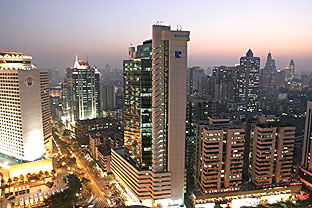
The approach to Guangzhou is spectacular. Looking down on it at night you can see the Pearl River snaking through the heart of the city, edged with green and orange lights. The rest of the city is a blaze of different colours, while the many skyscrapers throw needles of light up into the night sky. Guangzhou is the capital of Guangdong, otherwise known as Canton. Here they speak Cantonese rather than Mandarin and their cuisine is one of China’s four main cuisine styles. For a long time Guangzhou was the only port from where goods were exported from China and imported into the country. The Cantonese also settled in many other countries around the world. Most Chinese restaurants in other countries are actually Cantonese and every Chinatown is also Cantonese rather than Mandarin. The city has grown rapidly in recent years, partly on the back of Hong Kong’s success and also because nearby Shenzhen was mainland China’s first special economic zone. Hong Kong is just two and a half hours away by jet catamaran and three hours by coach.
At dinner I am just about to sip my tea when I'm told that in Guangzhou everyone washes their chopsticks in the tea first, then uses it to wash out the soup/rice bowl before tipping the tea into a large bowl in the centre. I have never come across this particular ritual before. The meal includes camel meat, fish heads and duck blood. I smile and tuck in, hiding my true feelings. The dinner conversation turns to SARS. The city is where it first appeared, and there are stills signs of it with warning notices in hotels, shops, at the airport and on buses, and some people wearing face masks in the street. But the general feeling is of optimism it will not return.
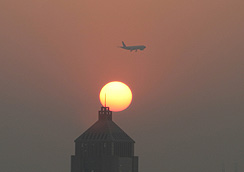
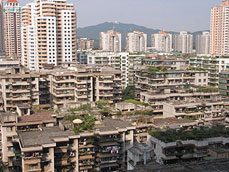
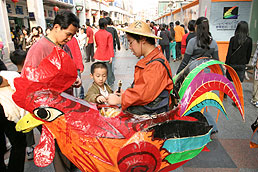
One of the first things I notice is the lack of bicycles in Guangzhou. It sets me wondering. Ae the people here so affluent they can afford to drive everywhere, or is the public transport system so effective they didn’t need to use them? Or is it just a case that there is so much traffic riding a bike is positively suicidal. I settle on a combination of all three. There is certainly a lot of traffic. The jams seem worse than Beijing's. it may be a city in a hurry, but for much of the time people are going nowhere fast. There are several hotels clustered together where we are staying, and a lot of designer clothes shops either already open or due to open. The area seems awash with money. Brand new BMWs, Mercedes and upmarket Japanese cars litter the car park and fill the roads in the area. There are also a lot of beggars, some very insistent, stopping directly in front of you with their begging bowls and tugging at your arms as you walk past. I buy some noodles for a beggar that night while in a convenience store. I much prefer to do that than give them money. At least I know where the money is going then.
The apartments in the city centre fascinate me. They all have bars over their windows, balconies and conservatories, some of which are very ornate. To me they look like a collection of bird cages piled on top of one another. The illusion is enhanced by the many pot plants and flowers spilling over the balconies and through the bars. I listen out for the sounds of birds singing but hear only the roar of traffic and occasional horn. One evening, cameraman Mr Qu and I go to the hotel's top floor to film the sunset over the city's skyscrapers. The sun co-operates and sets beautifully on the horizon. I miss a jet passing directly across the sun on its landing approach while I am changing lenses, but I hear whoops of joy from Mr Qu. He has it on film, and when I see his footage later it looks spectacular, with the plane passing straight in front of the sun. I have to make do with a near miss.
The city centre streets are full of shops. Beijing Lu is traffic-free and lined with pulsating neon signs, clothes stores, electronic and electrical shops and fast-food outlets. There are a couple of areas of the road with glass viewing screens so you can look down to preserved sections of old roads dating back to the Song Dynasty. We head to a nearby snooker hall where I am challenged to a couple of games, both of which I lose on the black ball, although I get my revenge next day. The Chinese are mad about snooker, and there are portraits of stars like Ronnie O’Sullivan, Jimmy White and Stephen Hendry up the stairs and around the hall. There are said to be many up and coming good snooker players in China who will make a big impact on the game. Watching some of the other players in the hall I can well believe it.
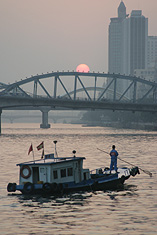
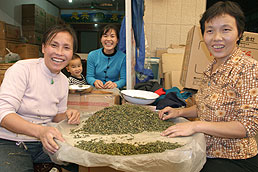
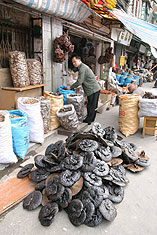
We have dinner one night at a restaurant in an area called Saigon, overlooking the Pearl River. It specialises in seafood and has a “live menu” in bowls outside the front including lobsters and crayfish, as well as cages containing chickens, pheasants, partridges and a sad-looking rabbit which I hope won’t end up on our dinner plates. It doesn’t, but the crayfish aren’t so lucky. The restaurant is near a suspension bridge, the cable support towers of which look like a pair of giant crayfish standing on their tails holding up the guy wires. Every so often a river cruise boat comes past in a blaze of blue, red and silver neon, the lights shimmering off the waves. Another couple of nights we eat at branches of the Dong Bei Ren Home-Style Jaozi Restaurant, or Northeast folk dumpling restaurant, part of a chain of serving traditional northeast cuisine and decorated in bright reds and oranges. We are sung a welcome by the staff, all of whom are from that region and dress in traditional Manchurian costume. Their white complexion and vivid dresses make some of the waitresses look like giant China dolls.
We go to the tea market in Fangcun. I can’t believe the number of tea shops or the amount of tea they each contain. No wonder people use the phrase "for all the tea in China" – there's obviously mountains of the stuff. Then we head to Shamian Dao, or Shamian Island, which was the only area were Europeans were allowed to live in the early 1800s. It has lovely avenues of mature trees with squares where people are playing badminton, and lots of colonial buildings reminiscent of London's South Kensington. Across the main road is the Chinese herb and spice market, or Peaceful Market. Guangzhou is known as the city where people eat anything, and this market underlines that. One shop has a giant stoneware vat on the floor and lots of glass jars on the shelves with what look like pickled animals or bits of animals in them. One contains a baby deer, its body and legs all squashed up and its neck and head grotesquely twisted. The market traders seem very reticent to talk to me on camera or let me photograph them or their stalls. I had read that the market has been raided by police in recent years in attempts to stop the illegal trade in rare and endangered animals and their parts. Were these people worried I might find something illicit, or that they might be filmed selling illegal items?
My eye is caught by bags full of seahorses and starfish on one stall. Next to the seahorses are a number of bats on skewers, their tiny legs and wings outstretched like furry little kites. They remind me of the Monty Python cinema sketch where the ice cream seller is selling albatrosses and gannets on a stick. Also on the stall are what look like bags full of cockroaches and a black powdery substance. On closer inspection I discover it is actually little black ants, and the thought of eating or drinking a potion made from either sends a shiver of revulsion down my spine. There are lots of dried snakes and I spot several boxes decorated with pictures of swallows, next to which are the nests from which birds nest soup is made. On another stall I see what I take to be small sliced mushrooms but which are in fact thin slices of deer antler, and there are turtle shells hanging up. They are good for your joints, I'm told. A couple of days later a local paper has a report about a Guangzhou inhabitant who is just about to chop up a live turtle with a meat cleaver when it cries out, and he is so struck with remorse he decides to take it back into the mountains and let it go. It’s good at least some people here have a conscience. I also see bundles of what appear to be small sticks but turn out to be centipedes or millipedes. I’m glad I didn’t meet them when they were alive. The final stall where we film is full of everything to do with deer, including full-size antlers. The stallholder shows me the remnants of the lower parts of deer legs, with the nails of the animals’ hooves still in place. She then shows me another box, giggling sheepishly as she opens it. Lillian, my interpreter, translates that it is deer testicles. They are rather shrivelled and attached to a long dried object which leaves little to the imagination. I am told that not only is it good for your health but is also a sort of long-term liquid Viagra. You mix it up with about 12 or 13 other ingredients – mostly bits of other animals plus some herbs – and it helps to revitalise your sex life. I thank the girl for sharing the information and showing me her wares, but add that I don’t need it.
In front of the market people are sorting through a pile of seahorses on the floor by a stall piled high with sacks of them. There must be many tens of thousands of them just in this one shop. The mind boggles at how many must be killed each year to satisfy the demand for medicinal potions. For a living thing of such delicate beauty to be reduced to these lifeless ingredients for man’s vanity or superstition strikes me as obscene, despite my pledge that I would not impose my own Western ideals on what I found in China. As we walk away from the market I wonder how many of the countless animals being sold whole or piecemeal have been taken from the wild, and how many are rare or endangered? I also wonder whether anyone cares. Thankfully a rally we come across the next day in the central area of the main shopping street, Shang Xia Jiu Lu, answers my question emphatically. Posters lining the street proclaim environmental slogans and warn that the killing of endangered animals will carry on as long as people carry on buying, while speakers advocate environmental messages from a large stage. It is gratifying to see this kind of public awareness in a city with such a notorious ecological reputation.
Near the market a trader is selling kittens in a cage and others have puppies on display in baskets and boxes. All of them look cute and irresistible. Some of the traders are not happy being photographed. I soon discover why. There is suddenly a big commotion and the traders grab their dogs, baskets and stools and run off down an alleyway. Moments later, a couple of policemen stride purposefully into the street, spend a couple of minutes walking around authoritatively as if to let everyone know they are aware what was going on, before disappearing themselves. Obviously the puppy and kitten sellers were trading illegally and their lookout had spotted the cops approaching. Having seen snack food stalls in Beijing selling dog meat and drunk a spirit in Guilin whose ingredients included dog testicles I couldn’t help wondering whether any that did not sell as pets might end up on dinner tables – if that is where they were not headed anyway.
Dinner that night is at a restaurant with cages outside including one containing a snake. I show too much interest in it and when we are at the table inside a waiter brings a bag to show us. It turns out to be the unfortunate snake, which has been ordered for my benefit. The waiter undoes the bag enough for it to squirm part-way out, giving a waitress a fright as she comes out of the kitchen and coming too close to my face for comfort. The snake returns a little while later, cooked and cut into thin strips. With everyone looking on expectantly, I take a bite of one and chew, and chew, and chew. It is far tougher than I expected, with very little meat. What meat there is does not have a strong taste – a little like chicken. But it hardly seems worth it for the amount of effort you need to get the meat. I leave most of it. To accompany the meal they order gall bladder in alcohol, which I drink in one go. Good for my chest, apparently.
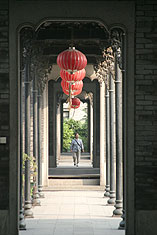
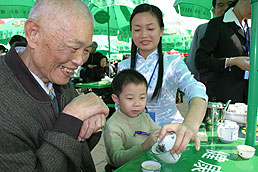
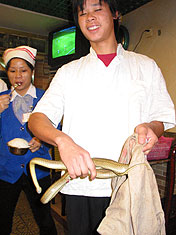
A huge outdoor tea festival is being staged at the city's futuristic exhibition centre. There is a lion dance demonstration which we do not have the necessary clearance to film close-up. We concentrate instead on the hundreds of tables laid out in rows, each of them with teapots and cups manned by girls in costume and shaded by green or red umbrellas. I am filmed having cups of tea with several people, including a couple of ladies who speak good English and tell me the particular tea we are being served is a mountain tea from Taiwan. The cups are very small but it is possible to get a taste of the different tea flavours. The ladies tell me that the tea is made with hot but not boiling water, and the cups need to be warmed first. I reply that in Britain we only use boiling water. We also drown the tea with milk and sugar. Some local photographers spot me drinking tea wearing my leather Indiana Jones hat and there is suddenly a scrum, all anxious to get pictures of me. As I stroll around a number of people call out hello. The atmosphere is very friendly, and I stop to photograph a couple of young children drinking tea with their parents and grandparents. One man stands and greets me, saying: “Welcome, welcome to my tea party.” He turns out to be a former university English lecturer and tells me he and his wife have just returned from a 15-day holiday in Europe, in which they visited 13 countries including spending three days in Britain. My new friend says he is nearly 80 and loved visiting England. I tell him I love China. He says he and his wife go to the tea party every year with their friends. I reply that it is the biggest tea party I have ever been to. I have no idea how many people are there but it seems like hundreds. I join the friends for a couple of cups of Yunnan tea, which is very nice with an aniseed after taste, before bidding goodbye.
We go back to Shang Xia Jiu Lu to film. It is packed with more shoppers than I ever recall seeing in Oxford Street. The quality of goods is inferior to Beijing Lu or around our hotel and the brand names all seem a rip-off of designer labels, as in Gugcci and a sports shop bearing a logo looking suspiciously like an amalgamation of Adidas and Nike. I like the stained glass windows above the shops, though. And the building facades all have a European look. It gives the upper storeys an Art Deco or Art Nouveaux feel. There are several McDonald’s restaurants along the street, each of them doing a roaring trade. I cannot understand how junk food can be popular in a city which has exported its cuisine around the world. A man in a chicken costume is selling what look like eggs but are in fact candy-coated olives. At the celebrated Tao Tao Ju restaurant, popular for afternoon tea and moon cakes, I try dishes including one of egg white and oil extracted from toads, called xue ge. Nearby is a street where the pavement is full of giant porcelain vases and pots – a china town in a Chinese town.
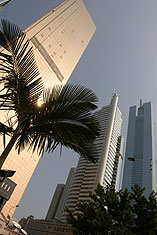
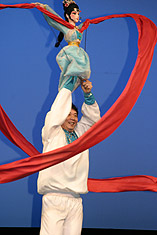
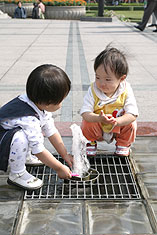
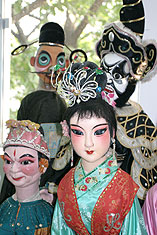
We go to the Mayor’s Plaza business centre to film some of the high-rise, high-tech buildings. The more we drive around the city the more obvious it becomes how much it is thriving. There are high-rise towers everywhere, some very striking architecturally. Many new ones are also being built. Unlike Oxford, described as a city of dreaming spires by poet Matthew Arnold, Guangzhou seems to be a city of gleaming spires, or perhaps of aspiring dreams. We go on to Zhongxin Square to film the giant man-made waterfall. I photograph some toddlers playing in the bubbling fountains then notice a group of teenage schoolgirls staring at me and giggling. They had followed me, and ask me for a picture. When I agree, the group suddenly grows and I am at the centre of another picture-taking frenzy. I am also asked to autograph their school exercise books. Several of the girls speak a little English and they want to know why I am in Guangzhou, where I come from and what we are doing. They are from a suburb and are on a day visit. I’m flattered but bemused by all the attention. During my time in China I have been mobbed by primary school children and now by autograph-seeking teenagers. I feel a bit like David Beckham, but without his money and lifestyle, of course.
The Li Wan area of the city houses the Xiguan Museum of Folk Custom, where there is a colonial-style house once owned by the regional HSBC chief, built in 1915. He used to travel to work on Shamian Island by canal, a 10-minute journey. Today the canal dock forms part of a lake in the garden of the museum, a tranquil setting marred by aircraft flying directly overhead. A newly-built replica of a Xiguan Grand House shows the style of traditional Xiguan houses, only 18 of which are now left. It is typical of Lingnan Culture and has tri-doors with wooden bars, door and outside shutters. Traditional stained-glass windows only have two patterns in China, one of them being butterflies. There is a lovely example above a door.
We also visit the Museum of West Han Dynasty and Nanyue king’s tomb. The most spectacular discovery in the tomb was the king's jade burial shroud, which had over 2,200 pieces of jade attached by silk thread. There were also barbecue cooking pots and implements similar to what is still used locally today.
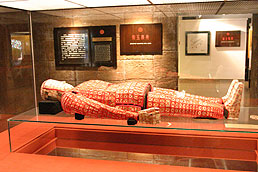
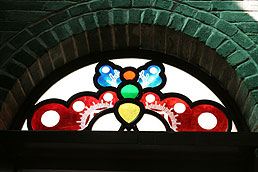
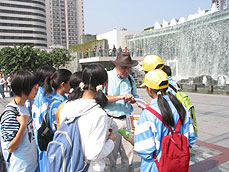
Then we head to the river for a sunset Pearl River cruise. The boat is modern and spacious, and there is a group of Americans on board who are in China to adopt abandoned baby girls – a legacy of China’s one-child policy. I don’t get to talk to them as we have to do quite a bit of filming out on deck, but I overhear some of their conversation. They obviously do not agree with the Chinese system, but are grateful to it because it is allowing them to come over and adopt children to take back to the US. During a meal earlier in our Guangzhou stay I talked to Lillian and a colleague, Ivy, about the one-child policy. Both believe it is not only a good thing but is necessary to ensure China’s population does not get out of hand. I find it interesting Ivy supports the policy, especially as she tells me her own family was fined heavily because they had two children and her uncle lost a senior post in the military for breaking the one-child rule. The authorities even came to her uncle’s house and took away furniture and other valuable items to sell. It seems a harsh way to enforce the policy. During the 90-minute cruise we pass by many bridges illuminated by garish neon lights, including the Crayfish Bridge. Close-up, the cable support towers look even more like giant crustaceans than they did from afar. The cruise goes past city-centre skyscrapers and colonial buildings right up to Bar Street, Fangcun, one of the new, happening night spots. After disembarking we drive there to film, but it is not particularly busy that night.
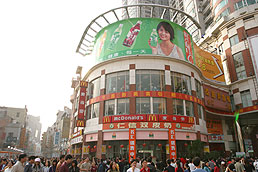
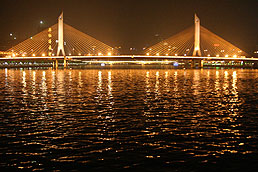
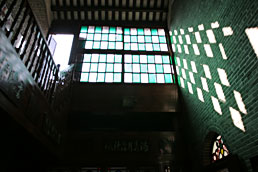
The Temple of the God of the Southern Sea, which contains some large and colourful statues, is in Huang Pu. This was the starting point of the Silk Road of the Sea and was a thriving port. For many years it was the only Chinese port which traded internationally and everyone who came to China from other countries or left china had to go via it. The ancient port fell into disuse because of rising land levels. The main port on the Pearl River, Miao Tou, is only 500 metres away although this area is now very tranquil with ducks swimming along the banana plantation-edged tributary of the Pearl River which still flows past.
At the Guangzhou Acrobatic Troupe and School we film several performers hat juggling, parasol juggling and doing balancing tricks, one guy spinning a large Ming-like vase on his head, another spinning a girl suspended from his teeth, and two girls doing an intricate diablo routine together. Then we watch a group of young girls doing diablo. The Chinese name for diablo is kong zhu, or hollow bamboo. I have a go myself after instruction. I am terrible at it but I gamely give it a go, on camera. The girls have been doing it for two years, but they tell me it takes six years to graduate from the training school. They have already performed on stage in Japan, Korea, France and other European countries performing at venues including large sports stadia. i think it would take me a lifetime to perfect.
The Pan Xi restaurant specialises in dim sum and I watch a lady making animal-shaped dim sum dishes. Shapes include hedgehogs, pigs, rabbits and birds. The restaurant makes over 2,000 types of dim sun. The lady says she has been making them for a numer of years after training for three years and can make many different animals. The pigs are the most popular ones, and my favourites as well. She can make 60 animals an hour, but just 30 hedgehogs as they are more complicated.
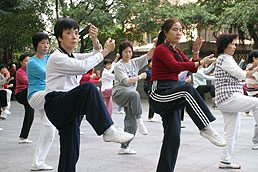
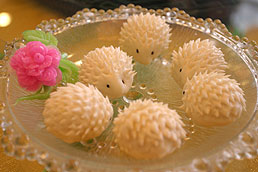
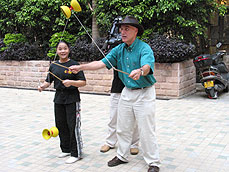
We go on to Guangzhou Puppet Arts Centre, where the Guangdong Puppet Troupe assistant manager demonstrates the turtle minister – one of four puppet styles. He imitates the puppet’s actions himself, explaining that it is a very important aspect of the puppeteer’s role. He or she has to act out the puppet’s actions to give them feeling and soul, like an opera performer. As he demonstrates, he really does put his heart and soul into it and makes the puppet character spring to life. I am then treated to special performances of puppet shows – glove puppets in small theatre, which I photograph from backstage as well as in front, and then other puppets in main theatre. One show reminds of the old Pinky and Perky show, with three guys operating large puppets playing guitar to Beatles numbers. Another involves a man dancing with a beautiful girl puppet and making flowing shapes with long red ribbons. It is very lifelike and moving, as though he is dancing with his lover. I watch him while surrounded by some of the theatre workers then talk to the puppeteer afterwards, surrounded by my new fan club. He says he has performed in England and other European countries. I ask him if he is married, and whether his wife minds him performing with his “lover” on stage. He laughs and says he is married, with a son. His family have got used to him performing and he says his devotion to the puppet is essential to bring out its sensitivity and spirit.
Yuexiu Park contains the statue of the five goats which is Guangzhou’s emblem. We film people doing tai chi at the bottom of the steps leading up to the statue, then spend just a few minutes at the top. I stay a bit longer getting shots of a lady doing tai chi in a pavilion with the sun behind her, taking a tumble as I rush down the steps. The cameras bounce better than I do, and there's no harm other than to my pride. We go on to the Chen Clan Temple, which has lovely, delicate corridors lined with lanterns and is decorated with three kinds of carvings – wood, stone and brick – as well as limestone and ceramic statues. The guide speaks excellent English and tells me there were only a couple of wooden ancestral name tablets left because all the rest had been destroyed in the Cultural Revolution, along with other historic relics. I ask her if she is angry about what had happened then because so much of China’s history has been lost forever and she says yes, but her attitude seems to be more that it was a shame it happened rather than apportioning blame to those who had perpetrated it.
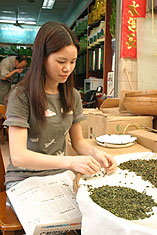
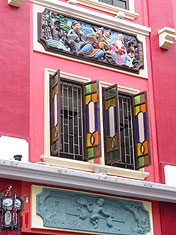
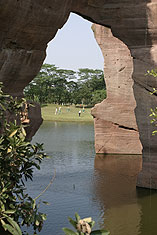
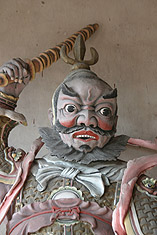
Guangzhou's passion with flowers is highlighted at the Flower Exposition Centre, basically a giant garden centre. We film in a penjing (Chinese bonsai) garden with some lovely, gnarled miniature trees. The owner tells me he grew most of the trees himself apart from a 42-year-old elm he adopted from a previous grower. He claims he has perfected a new technique in twisting the branches of the tree. The most valuable is a rare type of banyan which he says is difficult to grow as a penjing. It is worth $50,000 but not for sale. Unless someone offers him the money, I daresay.
Luhu Golf Club is one of nine golf clubs around the city and is right in the centre. After some deliberation they decide that they don’t want us to film there or me to play. We are told curtly that they don’t need the publicity as it is a private club, despite the fact that they welcome visiting golfers. Instead we go to Mount Baiyun Park and film at the top, from where there is a misty view over Guangzhou and the surrounding mountains. We go on to a hillside and film some people grass skiing.
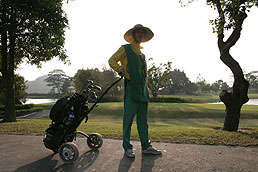
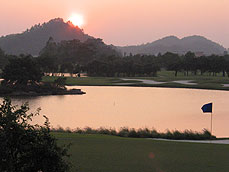
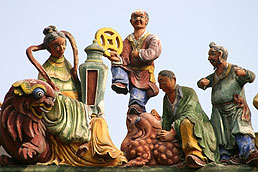
After the disappointment of Luhu, I finally get the chance to play golf in the outlying Panyu district, at the Bernhard Langer-designed Lotus Hill Golf Resort, a stunning 6,780-yard course rated one of the top five in China. We get a very warm welcome and I talk to the clubhouse manager about golf in China and at his club. We film several sequences of me hitting shots from various tees and fairways before the crew depart and leave me to play for the day. The caddies all wear coolie hats. As I prepare to go out for my round an army of them queue patiently by the clubhouse like immobile terracotta warriors, hoping to gain employment. The caddies are ranked in three tiers and I choose one from the top tier, costing about £11. His name is Ming, and he cheerfully guides me as I play on my own for the front nine holes, holding my cameras each time I swing at the ball. His optimistic assessments of clubs required for each shot flatter my ability but all too often result in me finding a hazard. I nickname him Ming the Merciless under my breath. On the back nine I am joined by an English ex-pat couple living in nearby Hong Kong, Keith and Marie Harding. Our golf doesn’t match the quality of the course, but it is enjoyable to spend time playing golf in the company of fellow native English speakers.
Golf is growing fast in China. Since the first course in mainland China was built just 20 years ago, there are now 200 – with hundreds more in the planning stages or being developed. The world’s largest golf complex – Mission Hills, which has 10 signature courses by designers including Greg Norman, Nick Faldo and Ernie Els – is close by at Shenzhen. Golf isn’t cheap in China. A round at Lotus Hill and other top courses costs about £100 for visitors. But it is well worth it just for the experience of playing there. The natural rocks used as features on the course reminded me of the incredible scenery around Guilin, while a tall pagoda high on a hill above the clubhouse add to the Oriental flavour.
Next stop: Qufu.